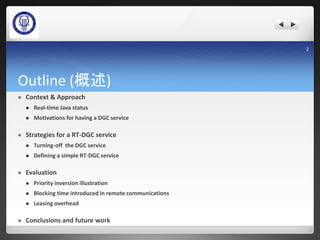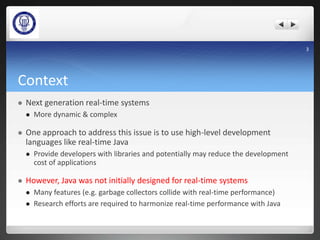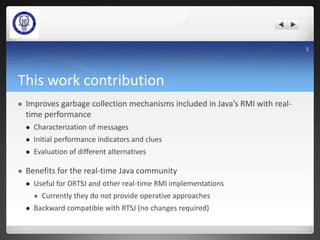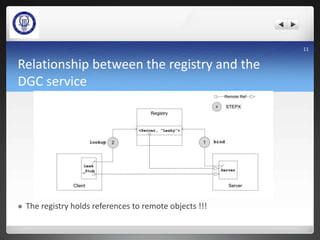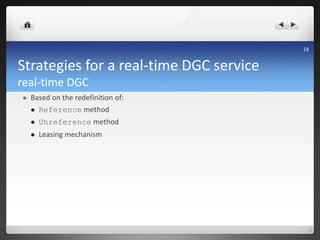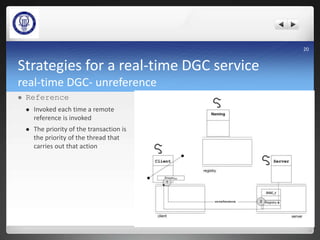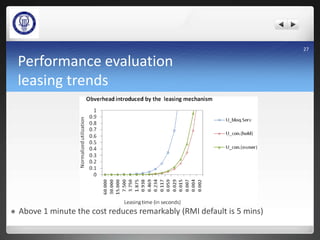Towards a garbage collector for distributed real-time Java
- 1. Towards Distributed Garbage Collection for Distributed Real-Time Java Pablo Basanta Val and Marisol García Valls Universidad Carlos III de Madrid (SPAIN) www.it.uc3m.es/drequiem/
- 2. Outline (概述) Context & Approach Real-time Java status Motivations for having a DGC service Strategies for a RT-DGC service Turning-off the DGC service Defining a simple RT-DGC service Evaluation Priority inversion illustration Blocking time introduced in remote communications Leasing overhead Conclusions and future work 2
- 3. Context Next generation real-time systems More dynamic & complex One approach to address this issue is to use high-level development languages like real-time Java Provide developers with libraries and potentially may reduce the development cost of applications However, Java was not initially designed for real-time systems Many features (e.g. garbage collectors collide with real-time performance) Research efforts are required to harmonize real-time performance with Java 3
- 4. State of the Art in Real-time Java Centralized systems Java VM, Specifications (RTSJ), Running products (Oracle, IBM, Jamaica) Currently in refinement in JSR-282 Safety critical applications Ongoing specifications and implementations Active in JSR-302 Distributed real-time Java Ongoing specifications (DRTSJ), and partial implementations (based on Java’s RMI) Stalled in JSR-50 and relaunched in 2012 4
- 5. This work contribution Improves garbage collection mechanisms included in Java’s RMI with real- time performance Characterization of messages Initial performance indicators and clues Evaluation of different alternatives Benefits for the real-time Java community Useful for DRTSJ and other real-time RMI implementations Currently they do not provide operative approaches Backward compatible with RTSJ (no changes required) 5
- 6. Distribution real-time Java model Based on the DREQUIEMI’s framework for distributed real-time Java It runs directly on RTSJ It extends Java’s RMI (Remote Method Invocations) with predictability It offers a predictable garbage collector for RMI Predictable = configurable priorities + scheduling parameterization 6
- 7. API of the scheduling service (in DREQUIEI) package es.uc3m.it.drequiem.rtrmi.server.dgc; import java.rmi.server.dgc.*; public interface RTDGCInterface extends java.rmi.Remote{ public void referenced(java.rmi.server.ObjID objid) throws java.rmi.RemoteException; public void unreferenced(java.rmi.server.ObjID objid) throws java.rmi.RemoteException; } 7
- 8. Motivation for having a distributed garbage collector Java requires a garbage collector 50% of all Java methods may allocate objects Static allocation is not a practical solution A distributed garbage collector is not mandatory in real-time Java It is not no so necessary as a local garbage collector (remote objects may be removed manually like in CORBA) However, it may be beneficial in terms of collecting unused remote objects RMI uses the model To remove unwanted remote objects 8
- 9. Memory Leaks avoided in Sun DGC DGC in RMI is based on counting algorithms It is not able to remove remote object cycles (to avoid problems) Acyclic structures may be collected (like the one in the figure) 9
- 10. Memory Leaks avoided in Sun DGC (2) Each potential invoation to remoteObjectLeak creates a memory leak After n invocations, there are n remote objects that may be collected 10
- 11. Relationship between the registry and the DGC service The registry holds references to remote objects !!! 11
- 12. Sun’s DGC algorithm sketched -reference list Based in leasing and reference lists Based on a algorithm described by Birrell previously Reference lists prevent remote object deallocation Remote references avoid remote object destruction 12
- 13. Sun’s DGC algorithm sketched -Leasing Leasing To deal with faulty scenarios Basic idea to wait for an update periodically Periodical renewal associated to a remote reference 13
- 14. Strategies for a real-time DGC service Two approaches To turn off DGC it requires new API methods to remove remote objects To produce a predictable version of DGC Requires a clear definition of priorities, periods (So that it may be schedulable as a real-time task) 14
- 15. Strategies for a real-time DGC service Turning DGC off Remote objects may removed at the server (with current API). 00:UnicastRemoteObject 01: static boolean 02: unexportObject 03: (Remote r, bolean force) 04: throws NoSuchObjectException; But it could be extended with a method to list all objects 00: UnicastRealtimeRemoteObject 01: static Vector 02: listExportedRemoteObjects(); Server node 15
- 16. Strategies for a real-time DGC service Turning DGC off (2) To allow explicit deallocation from a client 00: RealtimeRemote 01: boolean unReference(Remote r) 02: throw NoSuchObjectException; 16
- 17. Strategies for a real-time DGC service Turning DGC off Remote objects may removed at the server (with current API). 00:UnicastRemoteObject 01: static boolean 02: unexportObject 03: (Remote r, bolean force) 04: throws NoSuchObjectException; But it could be extended with a method to list all objects 00: UnicastRealtimeRemoteObject 01: static Vector 02: listExportedRemoteObjects(); Server node 17
- 18. Strategies for a real-time DGC service real-time DGC Based on the redefinition of: Reference method Unreference method Leasing mechanism 18
- 19. Strategies for a real-time DGC service real-time DGC- reference Reference Invoked each time a remote reference abandons a node The priority of the transaction is the priority of the thread that carries out that action 19
- 20. Strategies for a real-time DGC service real-time DGC- unreference Reference Invoked each time a remote reference is invoked The priority of the transaction is the priority of the thread that carries out that action 20
- 21. Strategies for a real-time DGC service real-time DGC- lease Lease Invoked periodically Modeled as periodic real-time invocation (T,D,C, Priority) 21
- 22. Strategies for a real-time DGC service real-time DGC- decoupled mechanisms To avoid synchronous reference and unreference methods Able decouple cost from remote invocations The reference and unreference methods are modelled as T,D,C transactions 22
- 23. Performance evaluation goals To build an scenario that illustrates that illustrates performance trends of current To evaluate the overhead introduced by the synchronous/asynchronous remote invocations To evaluate the overhead introduced by the leasing mechanism Reference software 796 Mhz machines x 1 real-time router (100 Mbits second) 23
- 24. Performance evaluation priority inversion trends A scenario that shows unbounded priority inversion was build Thread in client suffers priority inversion of al 24
- 25. Performance evaluation priority inversion due to DGC The real-time garbage collector may handle the priority properly 100 400 1600 6400 25600 100 1300 2500 3700 4900 6100 7300 8500 9700 10900 12100 WCRT(µs) T3_WCET (µs) RT-DGC and DGC impact on Worst Case Response Times CLIENT (with DGC) CLIENT (with RT-DGC) T3 (with DGC & RT-DGC ) 25
- 26. Performance evaluation deferred vs. synchronous costs Defered DGC reduces response times 26
- 27. Performance evaluation leasing trends Above 1 minute the cost reduces remarkably (RMI default is 5 mins) 27
- 28. Conclusions (结论) Distributed real-time Java applications require to deal with the garbage collector issue (disabling the DGC) Illustrated empirically The paper provides mechanisms to reduce the cost of garbage collection in distributed real-time Java Illustrated empirically 28
- 29. Ongoing work Extensive evaluation and formalization Benchmarks and formalism for the real-time DGC An extension to other real-time infrastructures Used to collect real-time SOA 29


